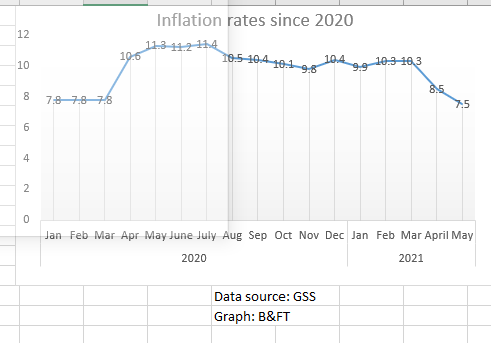The general rise in prices of goods and services had fallen back to its normal levels in May 2021, following continuous decline in the food basket; thereby bringing inflation back to its pre-pandemic status, data from the Ghana Statistical Service (GSS) have shown.
According to the data released yesterday, average inflation increased by 7.5 percent compared to 8.5 percent recorded in April and the 9.9 percent recorded in January 2021. This makes the May rate lowest since March 2020, when inflation recorded 7.8 percent.
The May food inflation was 5.4 percent, lower than both the 6.5 percent recorded las month and the average of the previous 12 months (11.3 percent). This further leads to food inflation decreasing significantly in its contribution to total inflation at 32.3 percent; the lowest contribution observed since the CPI basket was rebased in 2018. Comparatively, food inflation’s total contribution at the beginning of the year was 57 percent.
Non-food inflation also followed the same direction, as it saw a decline to 8.8 percent from the previous 10 percent. Inflation for imported goods was 7.3 percent, also down from 7.4 percent the previous month. Inflation for locally produced items was also 7.3 percent on average, down from the 8.7 percent recorded the previous month.
At the regional level, the overall year-on-year inflation ranged from 2.6 percent in Western Region to 12.3 percent in Greater Accra Region. Upper West Region recorded the highest month-on-month inflation at 4.3 percent. Three regions saw a stark decline in Food inflation as compared to last month.

Prior to its release, the Monetary Policy Committee of the Bank of Ghana unexpectedly cut the policy rate at its 100th meeting – despite initial fears that the increase in fuel prices and introduction of new taxes which kicked-in during May are likely to push prices up and boost inflation. However, the Committee said it is confident the new development will not push inflation up; hence, its decision to cut the rate to 13.5 percent after maintaining it for more than a year at 14.5 percent.
“Headline inflation eased sharply to within the medium-term target band, driven mainly by lower food prices and base drift effects, a tight monetary policy stance and stable exchange rate conditions. Since the initial shock to inflation in April 2020, the forecast showed that inflation will be close to the central target by June 2021. These forecasts remain broadly unchanged and inflation will remain within the target band in the next quarter.
“Risks to the inflation outlook appear muted in the near-term, but pressure from mostly rents and transport fares will require some monitoring to anchor inflation expectations. Under these circumstances, the Committee decided to lower the Monetary Policy Rate by 100 basis points to 13.5 percent. The Committee will continue to monitor price developments closely and take appropriate action, where necessary, to contain all potential pressures to the inflation outlook,” a statement from the Committee said.
The May inflation of 7.5 percent will therefore come as a relief to the Committee, as it provides reasons to justify the cut – at least for the meantime.










